2010 FORD FUSION HYBRID air conditioning
[x] Cancel search: air conditioningPage 29 of 329
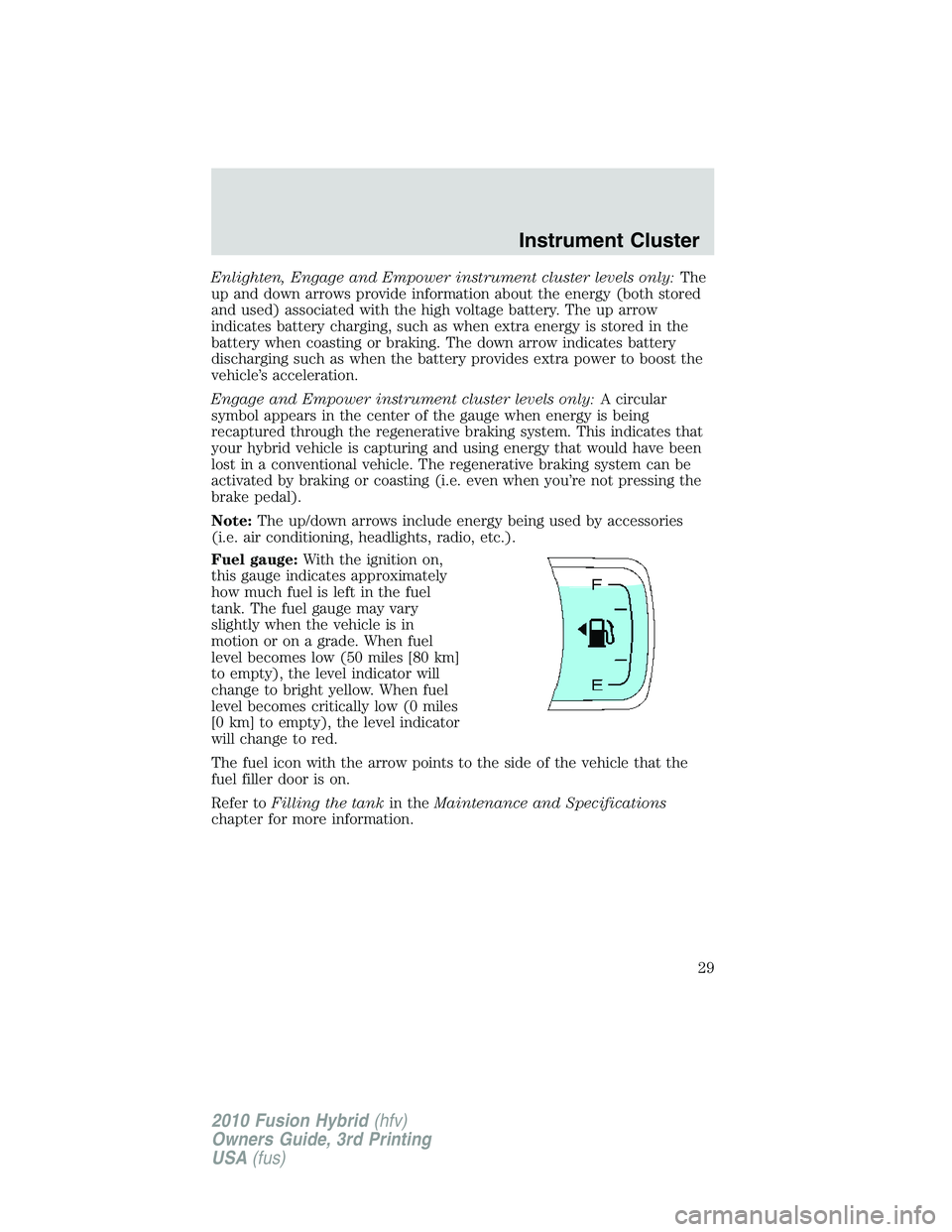
Enlighten, Engage and Empower instrument cluster levels only:The
up and down arrows provide information about the energy (both stored
and used) associated with the high voltage battery. The up arrow
indicates battery charging, such as when extra energy is stored in the
battery when coasting or braking. The down arrow indicates battery
discharging such as when the battery provides extra power to boost the
vehicle’s acceleration.
Engage and Empower instrument cluster levels only:A circular
symbol appears in the center of the gauge when energy is being
recaptured through the regenerative braking system. This indicates that
your hybrid vehicle is capturing and using energy that would have been
lost in a conventional vehicle. The regenerative braking system can be
activated by braking or coasting (i.e. even when you’re not pressing the
brake pedal).
Note:The up/down arrows include energy being used by accessories
(i.e. air conditioning, headlights, radio, etc.).
Fuel gauge:With the ignition on,
this gauge indicates approximately
how much fuel is left in the fuel
tank. The fuel gauge may vary
slightly when the vehicle is in
motion or on a grade. When fuel
level becomes low (50 miles [80 km]
to empty), the level indicator will
change to bright yellow. When fuel
level becomes critically low (0 miles
[0 km] to empty), the level indicator
will change to red.
The fuel icon with the arrow points to the side of the vehicle that the
fuel filler door is on.
Refer toFilling the tankin theMaintenance and Specifications
chapter for more information.
Instrument Cluster
29
2010 Fusion Hybrid(hfv)
Owners Guide, 3rd Printing
USA(fus)
Page 33 of 329
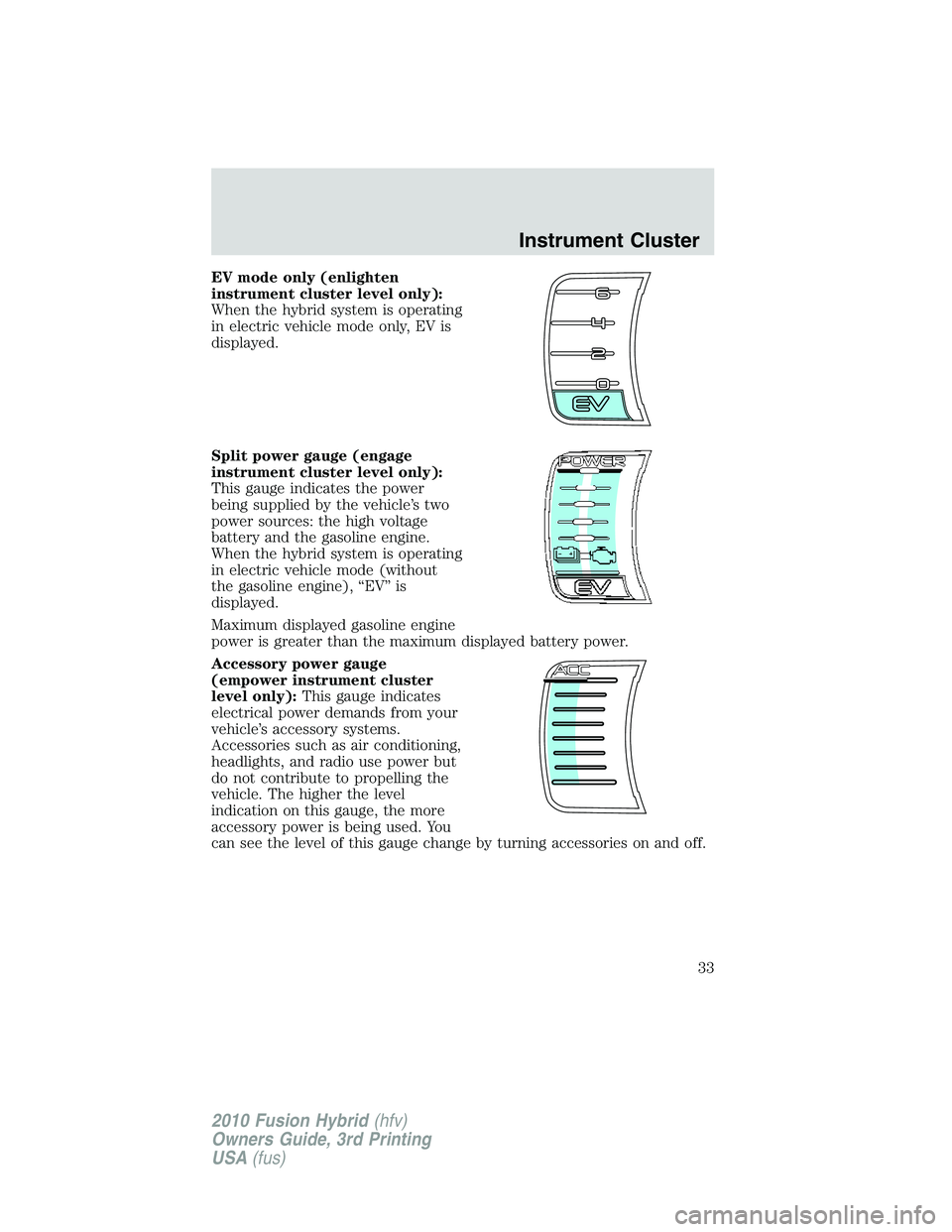
EV mode only (enlighten
instrument cluster level only):
When the hybrid system is operating
in electric vehicle mode only, EV is
displayed.
Split power gauge (engage
instrument cluster level only):
This gauge indicates the power
being supplied by the vehicle’s two
power sources: the high voltage
battery and the gasoline engine.
When the hybrid system is operating
in electric vehicle mode (without
the gasoline engine), “EV” is
displayed.
Maximum displayed gasoline engine
power is greater than the maximum displayed battery power.
Accessory power gauge
(empower instrument cluster
level only):This gauge indicates
electrical power demands from your
vehicle’s accessory systems.
Accessories such as air conditioning,
headlights, and radio use power but
do not contribute to propelling the
vehicle. The higher the level
indication on this gauge, the more
accessory power is being used. You
can see the level of this gauge change by turning accessories on and off.
Instrument Cluster
33
2010 Fusion Hybrid(hfv)
Owners Guide, 3rd Printing
USA(fus)
Page 70 of 329
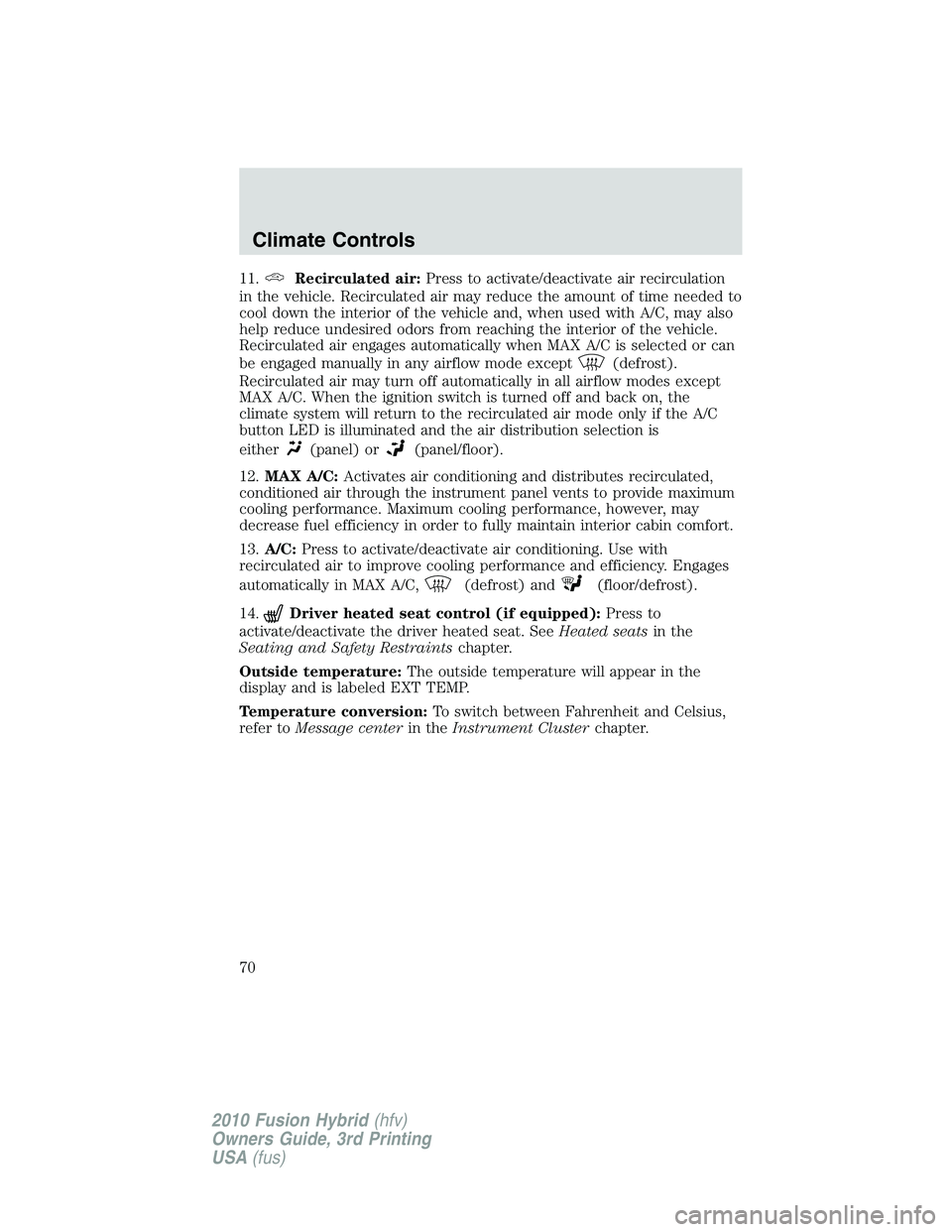
11.Recirculated air:Press to activate/deactivate air recirculation
in the vehicle. Recirculated air may reduce the amount of time needed to
cool down the interior of the vehicle and, when used with A/C, may also
help reduce undesired odors from reaching the interior of the vehicle.
Recirculated air engages automatically when MAX A/C is selected or can
be engaged manually in any airflow mode except
(defrost).
Recirculated air may turn off automatically in all airflow modes except
MAX A/C. When the ignition switch is turned off and back on, the
climate system will return to the recirculated air mode only if the A/C
button LED is illuminated and the air distribution selection is
either
(panel) or(panel/floor).
12.MAX A/C:Activates air conditioning and distributes recirculated,
conditioned air through the instrument panel vents to provide maximum
cooling performance. Maximum cooling performance, however, may
decrease fuel efficiency in order to fully maintain interior cabin comfort.
13.A/C:Press to activate/deactivate air conditioning. Use with
recirculated air to improve cooling performance and efficiency. Engages
automatically in MAX A/C,
(defrost) and(floor/defrost).
14.
Driver heated seat control (if equipped):Press to
activate/deactivate the driver heated seat. SeeHeated seatsin the
Seating and Safety Restraintschapter.
Outside temperature:The outside temperature will appear in the
display and is labeled EXT TEMP.
Temperature conversion:To switch between Fahrenheit and Celsius,
refer toMessage centerin theInstrument Clusterchapter.
Climate Controls
70
2010 Fusion Hybrid(hfv)
Owners Guide, 3rd Printing
USA(fus)
Page 71 of 329

DUAL ZONE AUTOMATIC TEMPERATURE CONTROL (NAVIGATION
BASED – IF EQUIPPED)
1.CLIMATE:Press to control the climate control system through the
touch display screen. SeeTouchscreen functionslater in this section.
2.
RRear defroster:Press to activate/deactivate the rear window
defroster. This button will also activate/deactivate the heated mirrors (if
equipped). Refer toRear window defrosterlater in this chapter for
more information.
3.A/C:Press to activate/deactivate air conditioning. Use with
recirculated air to improve cooling performance and efficiency. A/C
engages automatically in MAX A/C,
(defrost)
and
(floor/defrost).
4.Passenger temperature:Press to increase/decrease the air
temperature on the passenger side of the vehicle. The recommended
initial setting is between 72°F (22°C) and 75°F (24°C), then adjust for
comfort. The passenger side temperature setting will appear in the
display.
5.
Passenger heated seat (if equipped):Press to
activate/deactivate the passenger heated seat. Refer toHeated seatsin
theSeating and Safety Restraintschapter for more information.
Climate Controls
71
2010 Fusion Hybrid(hfv)
Owners Guide, 3rd Printing
USA(fus)
Page 74 of 329

signify that the feature has been disabled. The system will return to the
previous mode afterDualis release.
To re-enable the smart-zone feature:Press and holdDualfor more
than four seconds. The driver’s temperature display will begin flashing to
signify that the feature has been re-enabled. The system will return to
the previous mode afterDualis released.
Max A/C:Activates air conditioning and distributes recirculated,
conditioned air through the instrument panel vents to provide maximum
cooling performance. Maximum cooling performance, however, may
decrease fuel efficiency in order to fully maintain interior cabin comfort.
VOICE COMMANDS IN CLIMATE MODE
Please refer to theVoice commands in climate modesection of the
Navigation supplementfor more information on using voice commands
with the climate control system.
Operating tips
•To reduce fog build-up on the windshield during humid weather,
select
(defrost) or(floor/defrost).
•To reduce humidity build-up inside the vehicle, do not drive with the
system OFF or with
(recirculated air) engaged and A/C off.
•Do not put objects under the front seats that will interfere with the
airflow to the back seats.
•Remove any snow, ice or leaves from the air intake area at the base of
the windshield.
•To improve the A/C cool down, drive with the windows slightly open
for 2-3 minutes after start up or until the vehicle has been “aired out.”
During extreme high ambient temperatures when idling stationary for
extended periods of time in gear, it is recommended to run the A/C in
the MAX A/C position, reduce blower fan speed from the highest setting
and put the vehicle’s transmission into the P (Park) gear position (for
automatic transmissions) to continue to receive cool air from your A/C
system.
For maximum cooling performance:
•Automatic operation:
1. Press AUTO for full automatic operation.
2. Do not override A/C or
(recirculated air).
Climate Controls
74
2010 Fusion Hybrid(hfv)
Owners Guide, 3rd Printing
USA(fus)
Page 89 of 329
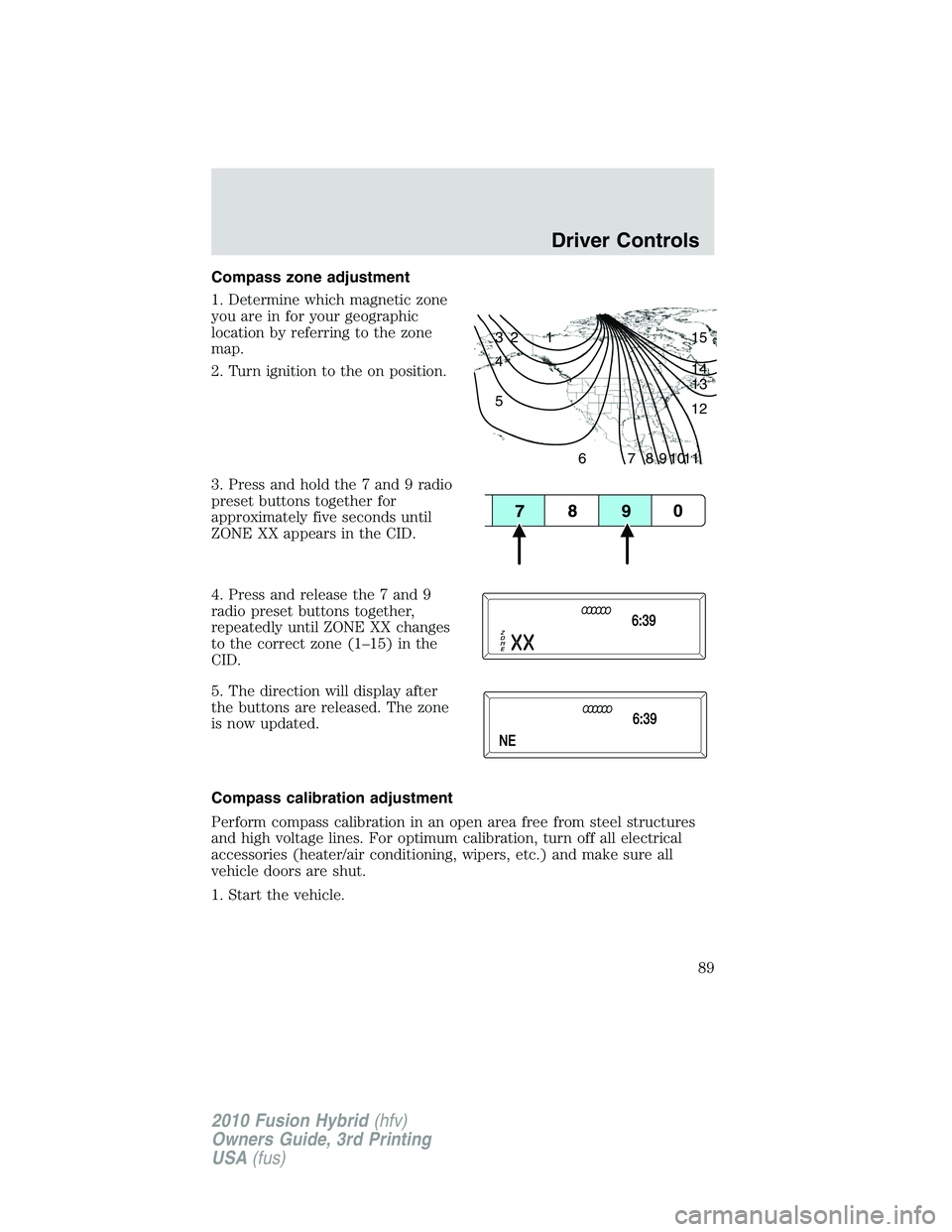
Compass zone adjustment
1. Determine which magnetic zone
you are in for your geographic
location by referring to the zone
map.
2. Turn ignition to the on position.
3. Press and hold the 7 and 9 radio
preset buttons together for
approximately five seconds until
ZONE XX appears in the CID.
4. Press and release the 7 and 9
radio preset buttons together,
repeatedly until ZONE XX changes
to the correct zone (1–15) in the
CID.
5. The direction will display after
the buttons are released. The zone
is now updated.
Compass calibration adjustment
Perform compass calibration in an open area free from steel structures
and high voltage lines. For optimum calibration, turn off all electrical
accessories (heater/air conditioning, wipers, etc.) and make sure all
vehicle doors are shut.
1. Start the vehicle.
1 2 3
4
5
6 7 8 9 101112 13 14 15
Driver Controls
89
2010 Fusion Hybrid(hfv)
Owners Guide, 3rd Printing
USA(fus)
Page 212 of 329
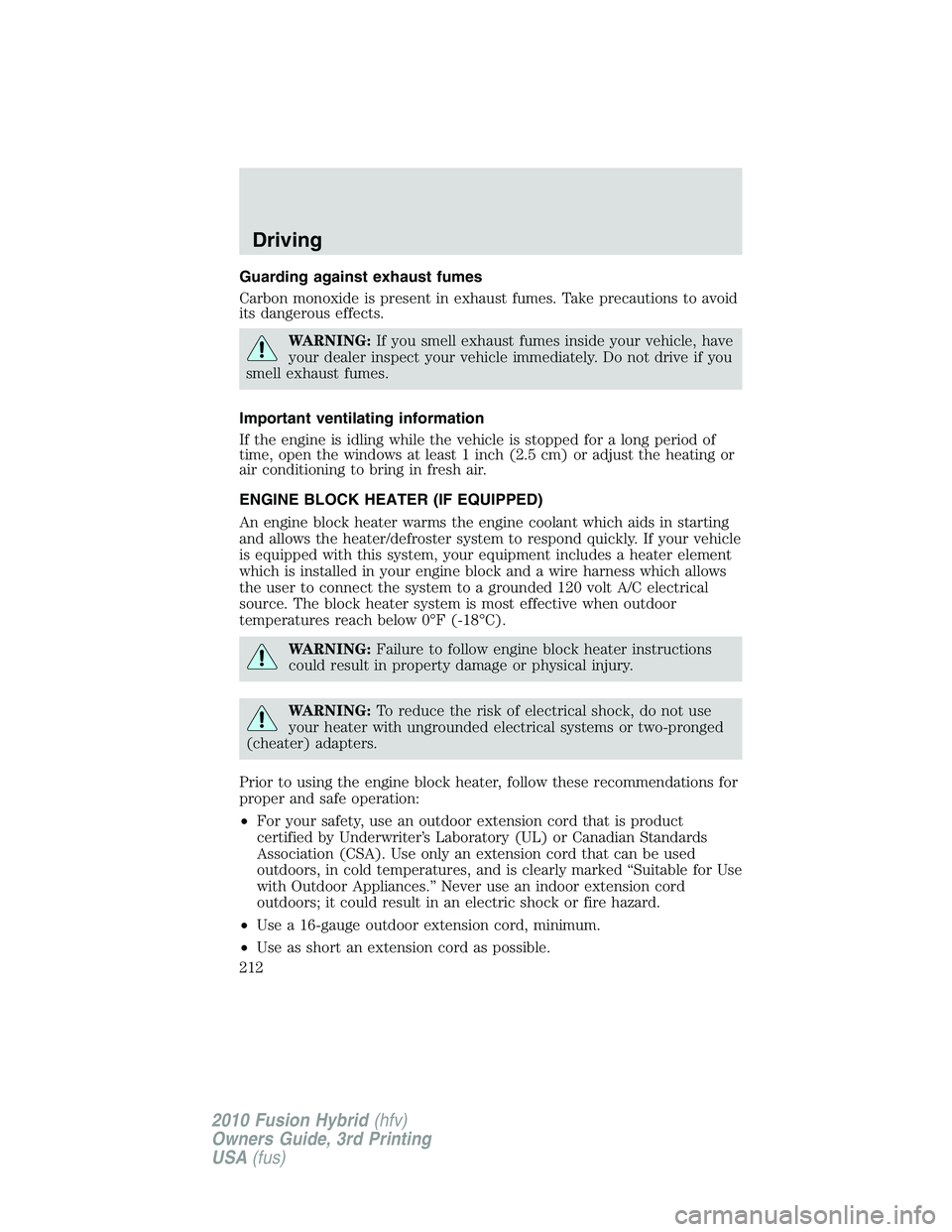
Guarding against exhaust fumes
Carbon monoxide is present in exhaust fumes. Take precautions to avoid
its dangerous effects.
WARNING:If you smell exhaust fumes inside your vehicle, have
your dealer inspect your vehicle immediately. Do not drive if you
smell exhaust fumes.
Important ventilating information
If the engine is idling while the vehicle is stopped for a long period of
time, open the windows at least 1 inch (2.5 cm) or adjust the heating or
air conditioning to bring in fresh air.
ENGINE BLOCK HEATER (IF EQUIPPED)
An engine block heater warms the engine coolant which aids in starting
and allows the heater/defroster system to respond quickly. If your vehicle
is equipped with this system, your equipment includes a heater element
which is installed in your engine block and a wire harness which allows
the user to connect the system to a grounded 120 volt A/C electrical
source. The block heater system is most effective when outdoor
temperatures reach below 0°F (-18°C).
WARNING:Failure to follow engine block heater instructions
could result in property damage or physical injury.
WARNING:To reduce the risk of electrical shock, do not use
your heater with ungrounded electrical systems or two-pronged
(cheater) adapters.
Prior to using the engine block heater, follow these recommendations for
proper and safe operation:
•For your safety, use an outdoor extension cord that is product
certified by Underwriter’s Laboratory (UL) or Canadian Standards
Association (CSA). Use only an extension cord that can be used
outdoors, in cold temperatures, and is clearly marked “Suitable for Use
with Outdoor Appliances.” Never use an indoor extension cord
outdoors; it could result in an electric shock or fire hazard.
•Use a 16-gauge outdoor extension cord, minimum.
•Use as short an extension cord as possible.
Driving
212
2010 Fusion Hybrid(hfv)
Owners Guide, 3rd Printing
USA(fus)
Page 312 of 329

Multi-point Inspection
In order to keep your vehicle running right, it is important that you have
the systems on your vehicle checked regularly. This can help identify any
potential issue before there are any problems. Ford Motor Company
suggests the following multi-point inspection to be performed at every
scheduled maintenance as the way to ensure your vehicle keeps running
right.
NORMAL SCHEDULED MAINTENANCE AND LOG
The following section contains the “Normal Schedule”. This schedule is
presented at specific mileage (kilometer) intervals with exceptions
noted.
Additional information available on the Web at
www.genuineservice.com or www.ford.ca
To learn more about the importance of routine and dealer-performed
maintenance on your vehicle, please visit the Ford Customer Service
Check every six months
❑Check lap/shoulder belts and seat latches for wear and function❑Check parking brake for proper operation
❑Check safety warning lamps (brake, ABS, air bag, safety belt) for operation
❑Check cooling system fluid level and coolant strength
❑Check low voltage (underhood) battery connections and clean if necessary
❑Check washer spray, wiper operation and clean all wiper blades (replace as necessary)
❑Check and lubricate all hinges, latches and outside locks. Inspect for correct operation
❑Check and lubricate door rubber weatherstrips. Inspect for excessive wear
❑Check and clean body and door drain holes. Inspect for clogs and obstructions
Multi-point inspection - Recommended at every visit
❑Check and top up fluid levels: brake, engine coolant recovery reservoir, motor/electronics reservoir and window washer.❑Inspect tires for wear and correct air pressure.
❑Check exhaust system for leaks, damage, loose parts and foreign materials.
❑Check low voltage (underhood) battery performance.
❑Check operation of horn, exterior lamps, turn signals and hazard warning lights.
❑Check radiator, coolers and heater and air conditioning hoses.
❑Inspect windshield washer spray and wiper operation.
❑Check windshield for cracks, chips and pitting.
❑Inspect for oil and fluid leaks.
❑Inspect half-shaft dust boots.
❑Check shocks, struts and other suspension components for leaks and damage.
Scheduled Maintenance Guide
312
2010 Fusion Hybrid(hfv)
Owners Guide, 3rd Printing
USA(fus)